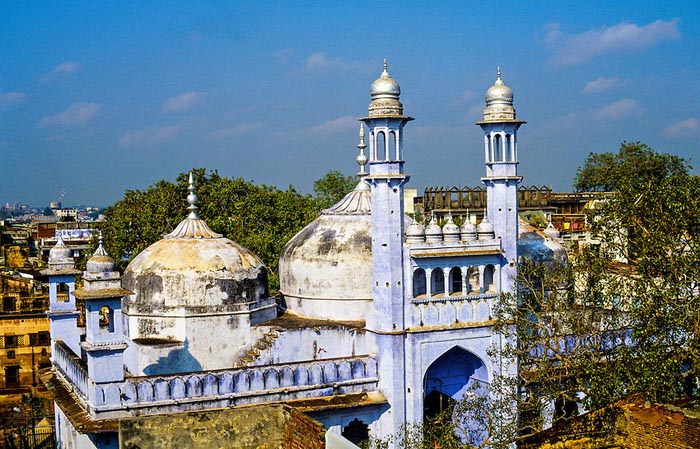Gyanvapi Mosque

Information on Gyanvapi Mosque (Varanasi, Uttar Pradesh) - History & Architecture
Gyanvapi Mosque is a popular masjid which is situated near Kashi Vishawanath Temple of Varanasi in Uttar Pradesh. It was created by Mughal king Aurangzeb after he destroyed the original Kashi Vishwanath Temple in the same location. In the north side of the masjid, there is the sacred river Ganga. At present, the masjid is managed by Islamic group named Anjuman Inthazamiya Masajid or AIM.
Gyanvapi Mosque Religious Significance
Gyanvapi Mosque was created in the year 1664 CE over the leftovers of the original Kashi Viswanath Temple which was dedicated to lord Shiv. The masjid was created by using the materials which were recovered from the temple. Due to this reason, the masjid is religiously delicate and sensitive for both Hindu and Muslim devotees. Afterwards, the masjid was named as Gyanvapi which signify 'the well of knowledge'. There is a well which is situated between the old temple and the current mosque. It is believed that the well is the location where the holy Shiv Linga icon of Kashi Viswanath Temple was concealed before it was destroyed by Aurangzeb.
The destruction of Kashi Viswanth Temple was inspired by the escape of Maratha ruler Shivaji and the revolt of local landlords. King Jai Singh, who was the grandson of king Man Singh is believed to enable Shivaji to avoid conflict with Mughal rulers. Furthermore, there was also records which tell that the Brahmins of Kashi Viswanath Temple has hindered with the Islamic wisdoms of Gyanvapi Mosque. The destruction of the temple was the indication of the warning regarding anti-Muslim groups by the Hindu religious people in Varanasi. At present, only the Muslim people are allowed to enter in Gyanvapi Mosque.
Gyanvapi Mosque Mythology
In accordance with Indian mythology, after the creation of Gyanvapi Mosque, a Maratha ruler named Malhar Rao Holkar desired to destroy the masjid and rebuild a temple in that location. However, he never conducted such act. In later phase, his daughter-in-law created the current Kashi Viswanath Temple in Varanasi which is situated nearby Gyanvapi Mosque.
In the year 1990, a Hindu religious group named Vishwa Hindu Parishad or VHP campaigned near Gyanvapi Mosque for retrieving the location of the masjid which was created after the destruction of a Hindu sacred place. After the fatal incident of the destruction of Babri Masjid, a strong police army was deployed in that area for preventing the similar occurrence in Gyanvapi Mosque. Furthermore, the political leaders of India also opposed with the demand of VHP on the ground that the location was dynamically used by Muslim devotees as a masjid. Due to high level of religious connection, Gyanvapi Mosque receives considerable safety under a special law named Places of Worship Act which was passed in the year 1991.
Gyanvapi Mosque Architectural Significance
Kashi Viswanath Temple was demolished and reconstructed multiple times in historical periods. At present, the temple structure which existed before the construction of Gyanvapi Mosque was most possibly created by king Man Singh through the supremacy of Mughal king Akbar. Gyanvapi Mosque possesses a mixture of Hindu and Muslim architectural style. In the masjid, only the wall of old Kashi Viswanath Temple has been retained.
The frontage of Gyanvapi Mosque is modelled partly according to the gateway of Taj Mahal. The key attraction of the masjid is 71 meter high towers above river Ganga. However, one tower of Gyanvapi Mosque was collapsed through the flood which occurred in the year 1948. The remains of former Kashi Viswanath Temple still can be observed in the basis of Gyanvapi Mosque such as in the supports and back portions of the masjid.